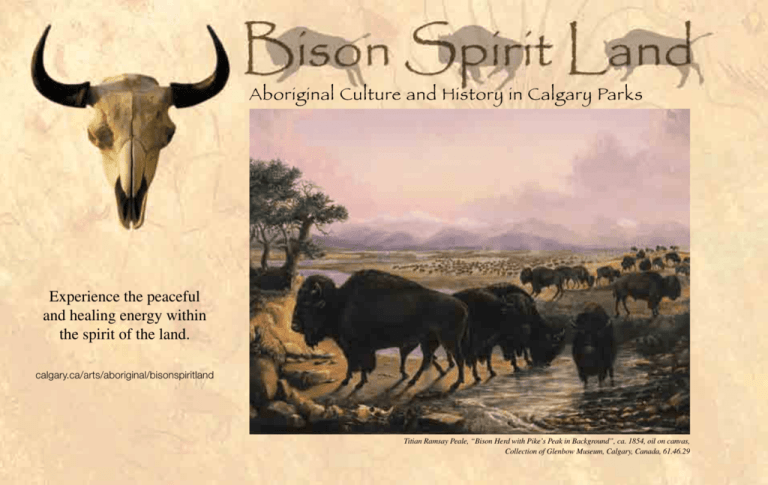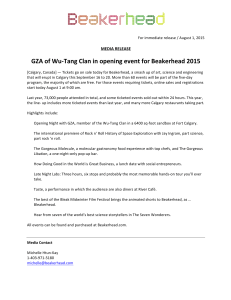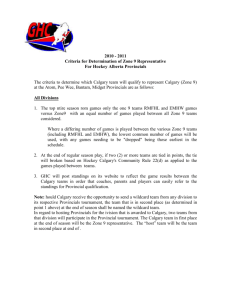Bison Spirit Land - Aboriginal Culture and History in Calgary Parks
advertisement

Aboriginal Culture and History in Calgary Parks Experience the peaceful and healing energy within the spirit of the land. calgary.ca/arts/aboriginal/bisonspiritland Titian Ramsay Peale, “Bison Herd with Pike’s Peak in Background”, ca. 1854, oil on canvas, Collection of Glenbow Museum, Calgary, Canada, 61.46.29 Secret to many Calgarians, the significance of the bison/ buffalo is core to artwork, dances and spiritual ceremonies. Hundreds of years ago, Aboriginal people followed and hunted the bison for their survival. The bison provided food and clothing for the people. All parts of the animal were used. Rope was made from the sinew, tools were made from the bones, and water containers were made from the intestines. The spirit of the buffalo continues to be honoured for its strength and wisdom. Many dances simulate the movement of the buffalo, honouring its spirit. Aboriginal cultures are based in the oral tradition. Stories and legends are used to transfer knowledge about the creation of the world to humans. Stories teach us about our responsibilities to maintain a respectful balance with the natural world. There is an understanding that all life forms were imbued with the same sacred energy when the Creator Spirit created the universe. Everything is interconnected in a complex relationship between the sky, land, water, and air. Ancestral knowledge is transferred through stories, dreams, and spiritual communication with non-human creatures such as the winged-ones, the four-legged, and water beings. In order to understand Aboriginal spirituality one must find a quiet place in nature and feel the power that resides within the tree people, the grandfather rocks, the female energy of water and the language of the animals. Calgary’s parks provide this re-energizing power. In them, a recipient can learn the lessons of wisdom that are etched in the land. The spirit of the bison and the voices of our native ancestors carry a strong message of healing, peace and care for ourselves and for our Mother Earth. Note: The term Aboriginal is currently recognized under the Canadian Constitution Act of 1982, which refers collectively to First Nations, Inuit, and Métis Peoples. The terms Aboriginal, First Nations, and Native are used interchangeably with reference to the original peoples of the land in this brochure. Washita Point (Plains Side Notched) Dated 500–300 years before present Archaeology Department, University of Calgary EE K OO TT R HARVEST HILLS DE ER F LAKE L L S HARVEST HILLS Nose Creek Parks & Valley V Native tribes camped along Nose Creek and the Bow and Elbow Rivers. With a bit of imagination, a person can visualize the bison roaming higher land and descending toward the rivers for water. Native groups lived according to the laws of nature and used the geography and topography of the land to hunt bison. Projectile points (arrowheads) were created from stone of local and distant sources, while the lay of the land allowed for natural buffalo jumps. During the glacial ice movement 15,000 years ago, Calgary was covered with water which would later become known as Glacial Lake Calgary. Nose Creek Valley became the spillway for the runoff of the Cordilleran and Laurentide glaciers. Over time, the movement of the glacier carved terraces and valleys into the landscape, luring bison and travellers to this area. The Foothills Erratic Train deposited many large boulders (erratics) from Jasper to Montana. Buffalo rubbed up against these erratics which have become known as “buffalo rubbing stones.” You can see such an erratic (now known as “Split Rock”) in Nose Creek Park where it was deposited thousands of years ago. Y D E WEST NOSE CREEK PARK D I N G T O EK E N T BEDDINGTON CRE D R HEIGHTS B E D D IN G T O N BLV D McCALL WY HUNTINGTON HILLS SADD MA 4 S T E Many archaeological studies reveal the past occupancy of native groups, their practices and the strong connection they had to the bison in their daily lives. The people were hunters who depended 64 AVE N mostly on the bison for their survival. To this day, the Blackfoot, Tsuu Tina and Stoney people honour the spirit of the bison through ceremonies, legends, dances and songs. A SKYLINE INDUSTRIAL WESTWINDS L E R ID G HEIGHTS T PARK THORNCLIFFE S LAYCOCK 11 ST E S B E R K IR V NOSE B B H L BARLOW TR V H A R B HILLS L E S COUNTRY D T H I STONEY 2 INDUSTRIAL C CR BARLOW TR COUNTRY HILLS BLVD INDUSTRIAL Photograph of Nose Creek, Airdrie by Line Laplante (2000) PRAIRIE WINDS E PARK BL VD ROYAL OAK C OUN T R Y HAMPTONS CITADEL C O U N T R Y H I L L S COUNTRY B LV D HILLS SANDSTONE VALLEY H I L L S B L V D MACEWAN B ARBOUR LAKE DR LAKE CROWFOOT HAWKWOOD NO SE H PARK ILL CROWFOOT B Nose Hill Park ARBOUR S B E R K H IR L V D E BEDDINGTON HEIGHTS EDGEMONT Nose Hill is particularly remarkable for its view of the foothills, mountains and plains. It is the largest park in Calgary to be left in its natural prairie grassland state. Nose Hill was created as the Cordilleran RANCHLANDS SCENIC ACRES Glacier pushed its way from the west and walled-up against the Laurentide Glacier coming from the northeast, mixing the earth with quartzite rock leftDALHOUSIE behind. As the glaciers receded, several erratics were deposited in the Calgary corridor, including one on Nose Hill. Many Napi legends and stories about the glacial erratics are significant to the Blackfoot Peoples. Many sites throughout the Calgary area reveal artifacts containing projectiles used SILVER SPRINGS for hunting bison and other animals. In honour of Aboriginal ancestors, preservation of these artifacts means leaving them untouched so thatVARSITY they can remain with the spirit of ESTATES BOWMONT the land and can serve as an offering to the Creator. Land of higher ground is said to PARK allow for closer contact with the spiritual realm since spirits travel faster in high, windy places. Numerous tipi rings and rock cairns which mark the location of vision quests BOWNESS PARK and campsites have been identified on Nose Hill. As a site of present and past ceremonies, the park continues to be a sacred place. GREENWOOD According to The Calgary Herald, March 13, 1897, a Blackfoot man named VARSITY BOWMONT BOWNESSto be buried at the foot of Nose Hill so that he could Running Weasel requested ACRES PARK “watch Calgary grow beneath his feet.” GREENBRIAR V D ED GE MO NT B L HUNTINGTON HILLS R S H AG A N A PPI T R S C E N IC TR DR RC SE EE S HI D LL N C H L A N NO D B L V SA B LV D A RES AC ST ON EY 53 ST W S I LV E R TR NOSE HILL PARK S P R IN G S H I L D T R D 56 AVE N LA UR IE BRENTWOOD BL VD NORTH CHARLESWOOD HAVEN HEIGHTS HIGHWOOD N E 40 A V S E L S RD R WN ES 34 AVE N HN A Y JO H HW ER DR RESEARCH C DA 77 ST W ANA RI V O U S IE W BO ST NS C 83 TRA ST W BO W LH NORTHLAND DR BAKER PARK A 14 ST W C DR W D O OO LV D R W B C E FOOTHILLS ESTATES CAMBRIAN HEIGHTS S E L E HEIGHTS R A RD RESEARCH 49 ST S H ES McCALL C WN W BO LAKE PARK CHARLESWOOD 32 AVE N DR AN I BR M CA COLLINGWOOD CONFEDERATION PARK NORTH WINSTON 24 N MONTGOMERY BANFF TRAIL FOOTHILLS Edworthy Park MOUNT PARK PLEASANT RSIT IVE UNIVERSITY HEIGHTS TUXEDO PARK PARK UN PARK PLEASANT CONFEDERATION ATHLETIC SHOULDICE CENTRE ST A V E EDMONT ON TR MOUNT ROSEMONT Y CAPITOL HILL HEIGHTS BALMORAL PLEASANT MOUNTVIEW HEIGHTS Prior to the ownership of the Calgary Pressed Brick and Sandstone Company, the area today known as Edworthy Park was Thomas REGAL PROMINENCE ROSEDALE Edworthy’s homestead. The original were the TERRACEof this land RENFREW CRESCENTinhabitants POINT ST. ANDREWS HEIGHTS HEIGHTS bison who were later followed by the Plains Indians. EDWORTHY BRIAR HILL PARKDALE PARK PATTERSON The terraced landscape of Edworthy Park was commonly used HOUNSFIELD POINT HEIGHTS HEIGHTS McKAY as a native campsite and buffalo hunting grounds. Topographical landSUNNYSIDE ST. GEORGE'S forms such as natural plateaus, coulees and steep cliffs left behind by UPPER HEIGHTS BRIDGELAND WEST HILLHURST the wonders of the glacial ice age would serve the bison hunters well, HILLHURST HILLHURST providing natural shelter, buffalo jumps and corrals. Edworthy Park LAWREY WILDWOOD is one of many areas throughout the Calgary valley where evidence EAU CLAIRE WESTMOUNT RIVERSIDE CHINATOWN GARDENS STRATHCONA has been found of bison processing areas where they PARK SPRUCE were corralled and processed for their meat, fur, CLIFF EAST and bone tools. ZOO FORT STRATHCONA VILLAGE CALGARY SUNALTA HEIGHTS Stone circles or tipi rings further add to WESTGATE ROSSCARROCK the evidence of native encampment, SCARBORO although most of these are SHAGANAPPI MILLS ESTATES difficult to identify and locate. The rings were formed from the rocks that were used to hold downCONNAUGHT the sides of the tipi. VICTORIA PARK Terraced settings such as those in Edworthy Park were ideal for setting up campsites since the treed northerly sides RAMSAY CLIFF LOWER of the valleys provided natural protection against the cold winter winds. BUNGALOW BANKVIEW MOUNT ROYAL GLENDALE Warm Pacific winds known as Chinook winds travel over the KNOB mountains and make Calgary the perfect place ERLTON MEADOWS HILL to winter. The bison and natives knew theKILLARNEY warming effect of Chinook winds and chose to winter here. Winter was MISSION GRANDVIEW GLENGARRY a time for the men to hunt buffalo and the women to sew new tipisRICHMOND and clothing and prepare pemmican (pulverized MOUNT ROYAL SIGNAL dried buffalo meat and crushed dried berries mixed with hot fat) for the upcoming year. SOUTH 16 A V E N DR R W O IA L D R RILEY PARK COACH HILL PRINCE'S ATH CO NA BLV D ISLAND PARK 4 AVE S K'S ISLA ND ST. T R 11 AVE S GE OR GE ISL AND 'S 1 ST E 12 AVE S BOW TR 9A VE MACLEOD TR 8 ST W D R 9 ST W A H C O N A S A R C E E S 11 ST E PARK 26 AVE S 33 ND MO RD AVE S ROXBORO CALGARY RIDEAU 14 ST W GLENBROOK O W C H IL D TR RIDGE GLENCOE PARK 26 A V E CO N N EC T DA RT MO UT RD H ATHLETIC 5 ST OPTIMIST W 15 ST E 17 AVE S 37 ST W R PARK PAT RIC 9 AVE S T CHRISTIE ST. 4 ST W STR 5 AVE S 6 AVE S BOW RIVER ST 69 ST W 10 ST EM EK RE C SE NO M OR 26 AVE S TY CAPITOL HILL 16 MOUNTVIEW HEIGHTS N E A V BALMORAL PLEASANT HEIGHTS 16 AVE N DR IA HILL PARKDALE L D W HOUNSFIELD R HEIGHTS McKAY RILEY PARK WEST HILLHURST LAWREY GARDENS OD INDUSTRIAL CROSSROADS 10 ST R RENFREW HEIGHTS BRIAR POINT TERRACE CRESCENT ST. ANDREWS HEIGHTS O EK RE EM FRANKLIN C SE Fort Calgary ST. GEORGE'S INDUSTRIAL HEIGHTS BRIDGELAND PRINCE'S HILLHURST HILLHURST MERIDIAN SUNNYSIDE UPPER ISLAND PARK MAYLAND HEIGHTS The North-West Mounted EAU CLAIRE Police built RIVERSIDE ALBERT PARK CHINATOWN Fort Calgary in 1875 at the confluence of the SPRUCE Bow and Elbow Rivers. One reason for the CLIFF CENTURY EAST construction of the Fort was to deter illegal PARK ZOO FORT VILLAGE CALGARY trade of alcohol and furs with the Americans. SUNALTA The other reason was to establish a point of PEARCE RADISSON HEIGHTS ESTATE SCARBORO contact between the three major native tribes SHAGANAPPI of the Blackfoot, Sarcee (Tsuu T’ina) and MILLS ESTATES VICTORIA CONNAUGHT PARK Stoney peoples for the purpose of signing treaties. Government Indian agents, Métis RAMSAY CLIFFthe lives interpreters and the arrival of the Canadian Pacific Railway forever changed LOWER BUNGALOW BANKVIEW MOUNT ROYAL of the native tribes who followed the buffalo. KNOB SOUT HILLbetween the Royal Canadian Mounted Police (formerly ERLTON A positive relationship INGLEWOOD GRANDVIEW KILLARNEY North-WestGLENGARRY Mounted Police) and the First Nations people has been cultivatedMISSION over time. RICHMOND However, the Department of Indian Affairs strippedMOUNT away native traditions and cultural practices and replaced these with restrictions, imprisonment and imROYAL SOUTH positions of European laws. Several photographs of the Blackfoot, Sarcee andROXBORO Stoney people at Fort Calgary reveal obvious differences between two distinct WEST DOV CALGARY RIDEAU cultures. PARK Prior to European settlement, natives hunted bison and GLENCOE lived a traditional way of life here. When Europeans settled in, the bison disappeared, treaties were BURNSLAND signed, reservations were created and boarding schools served to assimilate native peoples into a “civilized” society. With no bison left to hunt and PARKHILL RUTLAND DOVER ELBOW PARK repeated epidemics of smallpox, measles, whooping cough and other foreign diseases, the survival of the native population was clearly threatened. Culture PARK GLEN CFB CURRIE was severelyCFBimpeded and traditional native ways were virtually crushed. Native populations were forced to rely on the white man for beef and clothing. CALGARY Today, the sins of ourCURRIE forefathers are being recognized and the scales areELBOYA returning to a semblance of balance. Celebrations of the bison spirit among BONNYBROOK native peoples continues toMQ'Shave a powerful impact on strengthening and honouring native INDUSTRIAL HIGHFIELD MANCHESTERcultures. ALYTH WESTMOUNT 28 4 AVE S 5 AVE S ST 6 AVE S ST. PAT RIC K'S ISLA ND 9 AVE S ST. 11 AVE S 9A VE 11 ST E 4 ST W RT MO DA 26 A V E CO N N EC T UT H 26 AVE S OR 26 AVE S RD OWS 5 ST 37 ST W ALE W 15 ST E S 19 8 ST W 9 ST W 1 ST E 12 AVE S BOW TR MACLEOD TR ARROCK GE OR GE ISL AND 'S ST BOW RIVER INGLEWOOD WILDLANDS INGLEWOOD BIRD BA R LO 14 ST W S D RIVER R D SO N OW LB ER RI V HIGHFIELD CONNECTOR 42 AVE S STANLEY W PARK Y BRITANNIA INDUSTRIAL VALLEYFIELD D A R LINCOLN PARK ALTADORE SANDY PARK BEACH GLENMORE G T FOOT TR R I C H LEOD TR INDUSTRIAL STANLEY R D MAC A IC H PARK R DR ON HM RIC AVE C R O W C H IL D 33 W TR TR SANCTUARY E M NO REGAL ROSEDALE John Hammond, “View Near Calgary”, 1894, oil on canvas, Collection of Glenbow Museum, Calgary, Canada, 987.97.1 14 S T BAYVIEW CARBURN PARK HAYSBORO BARLOW T SOUTH GLENMORE PARK 18 ST E S RIVERBEND ACADIA OAKRIDGE PALLISER SOUTHLAND DR DR Fish Creek Provincial Park W PA R K W IL L O MAPLE WILLOW PARK RIDGE BO N DOUGLAS AV E N T U R E GLEN ACADIA DR D R DR CEDARBRAE 24 ST W SOUTHWOOD BRAESIDE Following the retreat of the glaciers, animals such as the mammoth, bison, camel, elk and horse began to walk the valley of Calgary. Archaeological findings reveal a long trail of animal bones that date back to 8,500 – 11,000 years ago. The volcanic eruption of Mount Mazama in Oregon 6,850 years ago spewed Mazama Ash as far north as Calgary leaving a distinctive 10 centimetre, white layer as a key identifier in the soil profiles. ELBOW ANDERSON RD ACE BONAVISTA BO TR MACLEOD COVE E K R LAKE BONAVENTURE FISH CREEK PROVINCIAL PARK C A N Y O N BONAVENTURE M E A D O W S QUEENSLAND DOWNS W B O H C R E LAKE LK IS F ESTATES T FRASER FISH CREEK PROVINCIAL PARK DR FISH CREEK PROVINCIAL PARK Hundreds of years ago, native people camouflaged themselves in wolf hides, quietly crept up on the bison, then attacked the huge animals with spears made from their tips. As hunting techniques improved, natives funneled the bison through v-shaped rock piles and chased them over a steep cliff called a buffalo jump. The natural coulees of the land now known as Fish Creek Provincial Park formed ideal corrals and pounds in which to trap the bison. Hunters waited at the base of the jumps to finish the kill. Great respect was given to the bison spirit both before and after a kill, honouring the sacredness of its body that was offered by the Creator for the survival of the people. Special ceremonies always took place after a hunt to give thanks to the animal spirits. Today, the bison continues to be honoured in ceremonial dances and songs. EVERGREEN ESTATES DEER RIDGE SHAWNEE SLOPES PARKLAND 146 AVE S DEER RUN E AV E MILLRIS D B LV MILLRISE SHAWNESSY S 46 1 D LV KE B McKENZIE LA MID B LV D M I K D PAR SHAWNESSY LAKE MIDNAPORE LAKE LAKE MIDNAPORE McKENZIE D B F I SH MOUNTAIN C R E E K L A K TW S 14 AV E S 6 BRIDLEWOOD SOMERSET ST E PARK SUN VALLEY BLVD 16 2 B D LV L V M c K E N Z I E 130 AVE S DOUGLASDALE LAKE BONAVISTA B O T T O M WOODLANDS DIAMOND BONAVISTA DR WOODPARK BLVD DR ER RIV WOODVIEW LAKE CANYON MEADOWS W DOWNS WOODBINE LAKE SUNDANCE SUNDANCE W LAKE SIKOME MARQUIS OF LORNE TR L P A R R A C HA CHAPARRAL McKENZIE N W PARK Y INDUSTRIAL HIGHFIELD MANCHESTER ALYTH BRITANNIA INDUSTRIAL INDUSTRIAL STANLEY R D PARK ALTADORE LINCOLN SANDY PARK BEACH GLENMORE ATHLETIC PARK WINDSOR Weaselhead Natural Area GLENMORE CFB CALGARY CFB HARVEY ELBOW DR NORTH LINCOLN MQ'S PARK BURNS NORTH INDUSTRIAL T R D A R BLACKFOOT TR R I C H MAC LEOD TR R IC H GLAMORGAN D E E R FO O CALGARY T 58 AVE S CFB MANCHESTER SOUTH BELAIRE MEADOWas a result of a misunderstanding INDUSTRIAL The name Weaselhead came about on the part of an LARK Indian Agent (a government official) who MAYFAIR PARK thought he was looking at a weasel’s head when he LAKEVIEW saw Chief Bull Head drinking from the Elbow River. Chief Bull Head lived on Weaselhead Flats WEASELHEAD FLATS for approximately 50 years at the beginning of the twentieth century. In the 1700s, a smallKELVIN group of Sarcee people left the northern Beaver tribe of Peace River and FAIRVIEW travelled south to the traditional Blackfoot prairie land of Calgary. Many Sarcee people camped GROVE NORTH along the Weaselhead area far to the south and east. Linguistically they are related to the Apaches GLENMORE PARK KINGSLAND and Navajos in the south-western United States. OriginallyEAGLE the Sarcees were called the Tsuu T’ina people but again, a misinterpretation of RIDGE their name resulted in theCHINOOK altered name of Sarcee or Sarci. In 1987, the Sarcee name reverted back PARK to the original name of Tsuu T’ina. At the making of Treaty 7 in 1877, Chief Bull Head and his people were to relocate and share reserve land with the Blood and Siksika tribes in southern Alberta. After a few years, the Sarcee could no longer live with this arrangement. Chief Bull Head and his warriors rode to BAYVIEWFort Calgary and demanded reserve land in their former setting. New reserve land was set aside SOUTH GLENMORE CARBURN for the Sarcee in 1833 on what is now the southwest side of Calgary’s city limits. PARK PARK HAYSBORO Looking towards the west is Moose Mountain, a sacred place where the Tsuu T’ina people continue to hold ceremonies and vision quests and where many of their herbal medicines are picked. The TsuuACADIA T’ina people are now PALLISER successfully raising and managingOAKRIDGE a growing herd of 250+ bison on their reserve. HARVEY MQ'S GL EN M OR E T R HERITAGE PARK GLENMORE RESERVOIR For your safety, reservoir closed to all users November 1 to April 30. Bylaw 9018 36/76 E W V S 14 S T A SOUTHLAND DR Washita Point (Plains Side Notched) Dated 500–300 years before present Archaeology Department, University of Calgary SOUTHWOOD W PA R K W IL L O DR WILLOW PARK BRAESIDE BO W 90 HERITAGE DR MAPLE RIDGE BEAVERDAM FLATS Blackfoot Confederacy and the Making of Treaty 7 The Blackfoot Confederacy comprises of the Kainaiwa (Blood), Piikáni (Peigan), Siksika (Blackfoot) and their allies the Tsuu T’ina (Sarcee). The making of Treaty 7 took place at Blackfoot Crossing near Cluny, Alberta in September 1877 between the Blackfoot Confederacy, the Stoney (Nakoda) and Her majesty the Queen. Reserve land was set aside for the five major groups in western and southern Alberta. Originally, the Bloods, Siksika and Tsuu T’ina were to share a common reserve while the Stoney and Peigan received separate lands. Over time, differences in language and cultural traditions prompted Chief Bull Head of the Tsuu T’ina to demand separate reserve land in their original campgrounds. In 1883 a new treaty was signed for the Sarcee people allocating reserve land between the Elbow River and Fish Creek. The land spans 18 miles east–west and 6 miles north–south. The Stoney/Nakoda First Nations main administration office is located in Morley, Alberta. The Nation is composed of three bands: the Chiniki, Bearspaw, and Wesley/Goodstoney. Morley is located in the foothills of the Rocky Mountains where the reserve straddles the Bow River. Two satellite reserves are located in Eden Valley (south of Morley) and Big Horn (to the north) where the Bighorn River and the North Saskatchewan River meet. All three bands are under one administration as one tribe. Blackfoot reserves are the Northern Peigan in Brocket, Bloods in Standoff, and Siksika in Gleichen. The Blackfoot territory stretches over a large area of land between southern Alberta and the United States. The American branch of the Confederacy is located in Montana. It was originally called the South Peigan tribe but is now simply known as the Blackfeet Indians. The word Ni-tsi-ta-pi means “real people” in the Blackfoot language. As with all Aboriginal languages: words, phrases, and concepts must be learned in their proper cultural contexts. It is as though Aboriginal languages contain a physical and spiritual (or shadow) topography, where the two realms exist as a seamless landscape. Ni-tsi-ta-pi describes a connection between the inner, spiritual aspect of a person to the outer, tangible world of Mother Earth. It is believed that a quiet, yet powerful energy can be felt from the “real people,” for they are one with the earth and the natural world. A composite of a visible and shadow side A connection to Mother Earth, Return to the peace of the land, the wisdom that lies in the heartbeat of the sounds of nature, and imagine looking through the eyes of a buffalo. See the land, wander through the valleys and coulees Drink from the Bow and Elbow Rivers Feel the warm Chinook breeze of a winter day Run with your herd Hear the call of the Creator asking you to give up your body for a ceremonial purpose of feeding the Native people, your kin, your brother, your sister. Hear the prayers of thanks for your life-giving offering Know that your spirit is honoured and remembers through time. The cycle continues as you walk in the grasslands, the prairies, the foothills Free as the wind that carries your breath For you are part of the Bison Spirit Land. Written by Line Laplante Crafts made by students at the Plains Indian Cultural Survival School (PICSS) (2000) – Aboriginal Cultural Instructor: Alvine Eagle Speaker (née Wolfleg) Note: The school was closed in 2002 to make way for the West LRT system. Community Linkage Aboriginal Tourism Glenbow Museum 130 – 9 Ave. S.E. Calgary, Alberta T2G 0P3 Phone: (403) 268-4100 Fax: (403) 262-4045 glenbow.org Eaglestar Tours Tours of Tsuu T’ina Nation For Reservations call: Hal Eagletail Phone: (403) 281-5769 Cell: (403) 988-7197 Email: hal.eagletail@gmail.com Nose Creek Valley Museum 1701 Main Street SW Airdrie, Alberta T4B 1C5 Phone/Fax: (403) 948-6685 Email: ncvm@telus.net nosecreekvalleymuseum.com Tsuu T’ina Museum Box 135 3700 Anderson Rd. S.W. Calgary, Alberta T2W 3C4 Contact: Jeannette Starlight Phone: (403) 238-2677 Email: cultural@tsuutina.com Printed in 2000. Reprinted 2003, 2005, 2013. Treaty 7 Tourism Suite 101, 12111 – 40 St. S.E. Calgary, Alberta T2Z 4E6 Phone: (403) 281-9779 Fax: (403) 281-9783 Email: tourism@treaty7.com treaty7tourism.org Education Nakoda Lodge P.O. Box 149 Morley, Alberta T0L 1N0 Phone: (403) 881-3949 Fax: (403) 881-3901 Department of Archaeology University of Calgary 2500 University Dr. N.W. Calgary, Alberta T2N 1N4 Main Office: (403) 220-5227 Limited number of copies can be obtained at: Culture Division’s Secretary The City of Calgary Cliff Bungalow Arts Centre Phone: (403) 476-4304 About the writer, Line Laplante, M. A. – Métis (French/Cree) from the Ottawa Valley. “When I feel that I am one with Mother Earth, it inspires me to write from the perspective of the land.” Learning, working, and participating in Aboriginal projects, Line continues to study the spirituality of the natural world. 2013-0965 Museums








